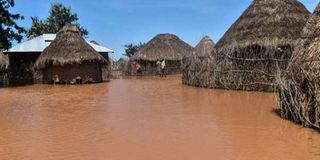Mitigate recurring drought and floods

A flooded homestead at Onkolde Village, Tana River County. PHOTO | ANDREW KASUKU | AFP
What you need to know:
Fresh in our minds is the 47 people who lost their lives in the Solai dam tragedy.
Last year’s heavy floods in Kwale, Mombasa, Taita-Taveta and Garissa, among 13 counties, left 26 people dead and 24,803 others displaced.
The scorching effect of droughts also leads to environmental degradation — desertification and bio-diversity loss.
Floods cause land degradation, erosion of river banks and increase soil erosion.
Drought is a creeping natural hazard that varies every other year in its intensity, duration and spatial distribution. Unfortunately, after food imports more than doubled from Sh114.56 billion in 2016 to Sh245.28 billion last year, the country is grappling with floods, whose damage extent and intensity is yet to be quantified.
Fresh in our minds is the 47 people who lost their lives in the Solai dam tragedy. Flood-related tragedies have occurred every four-and-a-half years, on average, since Independence, until the El-Nino-induced floods of 1997–98, which caused loss and damage of property valued at Sh15.14 billion. The previous seven episodes were not well-documented.
The El-Nino followed drought and came with a Rift Valley Fever epidemic that adversely affected livestock rearing.
The Kenya Red Cross said the floods caused 300 deaths and damage worth Sh2.36 billion to the agricultural sector.
HEAVY FLOODS
Last year’s heavy floods in Kwale, Mombasa, Taita-Taveta and Garissa, among 13 counties, left 26 people dead and 24,803 others displaced. Also, a huge number of livestock was lost.
Floods cause land degradation, erosion of river banks and increase soil erosion with the consequent silting of dams, thus complicating the recovery due to the damage caused.
But while floods seem to have about the same prevalence as droughts, the latter affect many more people because the water supply is reduced, leading to crop and livestock losses and thus reducing the amount of food available and, consequently, the deterioration of human health due to undernutrition and malnutrition.
Conflicts between communities in search for water and pasture and wildlife also increase.
The scorching effect of droughts also leads to environmental degradation — desertification and bio-diversity loss. The droughts that have had a significant impact occurred in 1983/84, 1991/92, 1995/96, 1999/2000, 2004, 2005/6, 2009, 2011 and 2016/17.
LIVESTOCK KILLED
The 1999-2001 drought was one of the country’s worst ever.
Affecting 4.4 million people, it killed nearly 60-70 per cent of the livestock in the arid and semi-arid areas and caused crop failure in most parts of the Rift Valley, coastal, eastern and central regions. Last year, 23 of the 47 counties required food support.
Many areas contend with famine and/or floods every other year, partly due to scarcity and mismanagement of water resources, ignorance and lack of information. Human activities such as deforestation and conversion of rangelands into irrigated farms and farm husbandry practices, including overgrazing and pollution of land and water sources, contribute to increased frequency and intensity of the disasters.
The coverage and impact have persisted, raising concerns over the effectiveness of the resilience measures put in place to mitigate them.
ADVERSE EFFECTS
Their increasing incidence and severity in the past two decades require holistic policy interventions in terms of preparedness and measures to minimise their adverse effects.
First, we need to implement the existing floods and droughts prevention and mitigation strategies. This includes improving catchment areas by conserving and protecting the ecosystem so as to check surface run-off, improve on soil infiltration and enhance groundwater storage.
That is in addition to public awareness campaigns on water saving and harvesting technologies, adopting conservation agriculture to ensure the soil structure and composition is preserved, to name but a few.
These strategies should encompass public participation that facilitates natural resource stewardship. In addition, to improve their effectiveness, we need to strengthen the drought, floods and disaster management agencies to ensure that programmes and response efforts are carried out in an effective, efficient and customer-oriented manner.
EARLY WARNING
Secondly, enhance collaboration among national, regional and global early warning systems, while developing homegrown information delivery systems that promote public understanding and preparedness for drought and floods.
That would improve early warning communication and awareness of the risks posed by floods and droughts and act as a driver towards prevention strategies. Improved delivery systems of the early warning communication would build trusted networks and improve the resilience of local communities.
Thirdly, create comprehensive financial instruments such as insurance to support mitigation and adaptation strategies.
DROUGHT RISKS
Insurance can be used as a climate-smart strategy to reduce vulnerability to flood and drought risks. In Kenya, this strategy is being used to provide a safety net to communities, making it easy to cope with drought risks. An example is Takaful Insurance Africa in the drought-prone Wajir County.
The strategy can be rolled out to other drought- and flood-affected regions.
Ms Laibuni ([email protected]) and Ms Kihiu ([email protected]) are policy analysts at the Kenya Institute for Public Policy Research and Analysis (KIPPRA).




